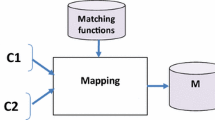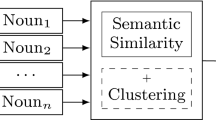Abstract
Geographical context is required of many information retrieval tasks in which the target of the search may be documents, images or records which are referenced to geaographical space only by means of place names. Often there may be an imprecise match between the query name and the names associated with the candidate sources of information. There is a need therefore for geographical information retrieval facilities that can rank the relevance of candidate information with respect to geographical closeness as well as semantic closeness with respect to the topic of interest. Here we present an ontology of place that combines limited coordinate data with qualitative spatial relationships between places. This parsimonious model of place is intended to support information retrieval tasks that may be global in scope. The ontology has been implemented with a semantic modelling system linking non-spatial conceptual hierarchies with the place ontology. An hierachical distance measure is combined with Euclidean distance between place centroids to create a hybrid spatial distance measure. This can be combined with thematic distance, based on classification semantics, to create an integrated semantic closeness measure that can be used for a relevance ranking of retrieved objects.
Access this chapter
Tax calculation will be finalised at checkout
Purchases are for personal use only
Preview
Unable to display preview. Download preview PDF.
Similar content being viewed by others
References
AAT (2000) Art & Architecture Thesaurus http://www.getty.edu/research/tools/vocabulary/aat/
Agosti, M., F. Crivellari, G. Deambrosis and G. Gradenigo (1993). “An architecture and design approach for a geographic information retrieval system to support retrieval by content and browsing,” Computers, Environment and Urban Systems 17: 321–335.
Alani, H., C. B. Jones and D. S. Tudhope (2001). “Voronoi-based region approximation for geographical information retrieval with gazetteers.” International Journal of Geographical Information Science; accepted for publication.
Beard, K. and V. Sharma (1997). “Multidimensional ranking for data in digital spatial libraries,” International Journal of Digital Libraries 1: 153–160.
Cuoclelis, H. (1992) Location, place, region and space. Geography’s Inner Worlds, R.F. Abler, M.G. Marcus and J.M. Olson (eds), 215–233. Rutgers University Press, New Jersey.
Curry M.R. (1996) The Work in the World–Geographical Practice and the Written Word. University of Minnesota Press, Minneapolis.
Doerr, M. and I. Fundulaki (1998) “SIS–TMS: A Thesaurus Management System for Distributional Digital Collections”. In Second European Conference on Rsearch and Advanced Technology for Digital Libraries, ECDL’98, Nikolaou, C. and Stephanidis, C. (eds), Heraklion, Crete, Greece, 215–234.
Gould P. and R. White (1986) Mental Maps. Allen and Unwin, London.
Guarino, N. (1997). Some organizing principles for a top-level ontology. Padova, National Research Council, LADSEB-CNR Int. Rep. 02/97.
Guarino, N. (1997). Semantic Matching: Formal Ontological Distinctions for Information Organization, Extraction, and Integration. In M. T. Pazienza (ed.) Information Extraction: A Multidisciplinary Approach to an Emerging Information Technology. Lecture Notes in Computer Science 1299, Springer Verlag: 139–170.
Guarino, N., C. Masolo and G. Vetere (1999). “ OntoSeek: Content-Based Access to the Web,” IEEE Intelligent Systems 14(3): 70–80.
Harpring, P. (1997). “Proper words in proper places: The Thesaurus of Geographic Names.” MDA Information 2(3): 5–12.
Hill, L. L., J. Frew and Q. Zheng (1999). “Geographic Names. The implementation of a gazetteer in a georeferenced digital library.” Digital Library 5(1): http://www.dlib.org/dlib/january99/hill/01hill.html.
Johnson, R.J. (1991) A Question of Place: Exploring the Practice of Human Geography. Blackwell.
Jones, C. B., C. Taylor, D. Tudhope and P. Beynon-Davies (1996). “Conceptual, spatial and temporal referencing of multimedia objects”. Advances in GIS Research II. M. J. Kraak and M. Molenaar (eds), London, Taylor and Francis: 33–46.
Jordan, T, M. Raubal, B. Gartrell and M.J. Egenhofer (1998) “An affordance-based model of place in GIS”. Proceedings 8th International Symposium on Spatial Data Handling, T.K. Poiker and N. Chrisman (eds), International Geographical Union, 98–109.
Kirn, Y. W. and J.H. Kim (1990) “A Model of Knowledge Based Information Retrieval with Hierachical Concept Graph”. Journal of Documentation, 46(2), 113–136.
Larson, R., R. (1995) Geographic Information Retrieval and Spatial Browsing. In GIS and Libraries Patrons, Maps and Spatial Information, Linda Smith and Myke Gluck (eds), Urbana-Champaign: University of Illinois, 1996. (p. 81–124).
Lee, J. H., M. H. Kim and Y. J. Lee (1993). “Information retrieval based on conceptual distance in IS-A hierarchies.” Journal of Documentation 49(2): 113–136.
Moss A., E. Jung and J. Petch (1998) “The construction of WWW-based gazetteers using thesaurus techniques”. Proceedings 8th International Symposium on Spatial Data. International Geographical Union, 65–75.
Rada, R., H. Mili, E. Bicknell and M. Blettner (1989). “Development and application of a metric on semantic nets.” IEEE Transactions on Systems, Man and Cybernetics 19(1): 17–30.
Relph E. (1977) Place and Placelessness. Pion Limited.
Richardson, R., A. F. Smeaton and J. Murphy (1994). “Using WordNet for conceptual distance measurement”. Information Retrieval: New Systems and Current Research: 100–123.
Rodriguez, M. A., M. I. Egenhofer and R. D. Rugg (1999). “Assessing semantic similarities among geospatial feature class definitions”. Interop’99. A. Vckovski, K. Brassel and H.-J. Schek (eds). Berlin, Springer. Lecture Notes in Computer Science 1580: 189–202.
Sintichakis, M., and P. Constantopoulos (1997). A method for monolingual thesauri merging. 20th Annual ACM SIGIR Conference on Research and Development in Information Retrieval, ACM Press, 129–138.
Smith, B. (1995). “On drawing lines on a map”. Spatial Information Theory A Theoretical Basis for GIS. A. U. Frank and W. Kuhn. Berlin, Springer. Lecture Notes in Computer Science 988: 475–484.
Smith, B. and D. M. Mark (1998). “Ontology and geographic kinds”. 8th International Symposium on Spatial Data Handling SDH’98, Vancouver, International Geographical Union, 308–320.
Spanoudakis, G. and P. Constantopoulos (1994). Measuring Similarity Between Software Artifacts. 6th International Conference on Software Engineering & Knowledge Engineering (SEKE’ 94), Jurmala, Latvia, 387–394.
TGN (2000) Getty Thesaurus of Geographic Names. http://www.getty.edu/research/tools/vocabulary/tgn/
Tuan Ti-Fu (1977) Space and Place: the Perspective of Experience. Edward Arnold.
Tudhope, D. and C. Taylor (1997). “Navigation via Similarity: Automatic Linking Based on Semantic Closeness.” Information Processing and Management 33(2): 233–242.
Tudhope, D., H. Alani, C. Jones (2001) “Augmenting thesaurus relationships: possibilities for retrieval”. Journal of Digital Information Vol. 1(8): http://jodi.ecs.soton.ac.uk/Articles/v01/i08/Tudhope/
Tversky, A. (1977). “Features of similarity.” Psychological Review 84(4): 327–352.
Walker, D., I. Newman, D. Medyckyj-Scott and C. Ruggles (1992). “A system for identifying datasets for GIS users.” International Journal of Geographical Information Systems 6(6): 511–527.
Author information
Authors and Affiliations
Editor information
Editors and Affiliations
Rights and permissions
Copyright information
© 2001 Springer-Verlag Berlin Heidelberg
About this paper
Cite this paper
Jones, C.B., Alani, H., Tudhope, D. (2001). Geographical Information Retrieval with Ontologies of Place. In: Montello, D.R. (eds) Spatial Information Theory. COSIT 2001. Lecture Notes in Computer Science, vol 2205. Springer, Berlin, Heidelberg. https://doi.org/10.1007/3-540-45424-1_22
Download citation
DOI: https://doi.org/10.1007/3-540-45424-1_22
Published:
Publisher Name: Springer, Berlin, Heidelberg
Print ISBN: 978-3-540-42613-4
Online ISBN: 978-3-540-45424-3
eBook Packages: Springer Book Archive




